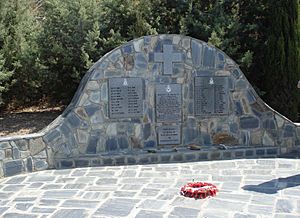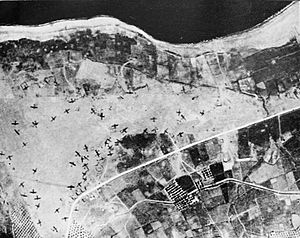Battle of Maleme facts for kids
Quick facts for kids Battle of Maleme |
|||||||
|---|---|---|---|---|---|---|---|
| Part of the Battle of Crete | |||||||
|
|||||||
| Belligerents | |||||||
| Commanders and leaders | |||||||
| Strength | |||||||
| ~ (21st, 22nd, 23rd Battalion New Zealand Infantry; 30Sqn & 33Sqn Royal Air Force groundcrew; Cretan Villagers with improvised peasant weapons & gendarmerie) | ~ (one parachute infantry regiment & 100th Mountain Regiment appearing after control of airport) | ||||||
| Casualties and losses | |||||||
| Unknown | Unknown | ||||||
The Battle of Maleme was a major fight during the Battle of Crete in World War II. It happened in 1941 as part of the German plan to take over the island of Crete. The Germans, using special paratrooper soldiers called Fallschirmjäger, planned to land in three main areas: Heraklion, Maleme, and Rethymno. This big plan was called Operation Merkur.
The German attack relied on their airborne troops, who jumped from planes or landed in gliders. A big mistake happened during the battle. Even though they were in a strong position, New Zealand troops left a very important hill, known as Hill 107. The Germans quickly took over this hill. This allowed them to capture the nearby airport. Once the airport was under German control, they could bring in many more soldiers and supplies. This event was a turning point, leading to the Germans taking over the entire island of Crete.
Contents
Why the Battle of Maleme Happened
Greece joined World War II when Italy attacked it in October 1940. Britain and its allies, like New Zealand, sent soldiers to help Greece. British forces also guarded Crete. This allowed Greek soldiers from Crete to go and fight on the mainland. Crete was very important to the British. It had excellent harbours for the Royal Navy in the eastern Mediterranean Sea. British bombers based on Crete could also reach important oil fields in Romania.
In April 1941, Germany invaded mainland Greece. The British and Allied forces had to leave. Many of them went to Crete to help defend it. However, most of these soldiers had lost their heavy weapons and equipment.
The German army leaders were busy planning to invade the Soviet Union. They did not really want to attack Crete. But Adolf Hitler, Germany's leader, was worried about attacks on the Romanian oil fields from Crete. German air force (Luftwaffe) commanders were very keen to capture Crete using an airborne attack. Hitler decided that Crete would be a key base for air attacks in the eastern Mediterranean. He ordered the attack to happen in May and not to delay the invasion of the Soviet Union.
Who Fought at Maleme
Allied Forces on Crete
The Royal Air Force (RAF) did not have many units permanently on Crete until April 1941. But they had started building airfields and radar stations. By the end of April 1941, Major-General Bernard Freyberg, a New Zealander, became the commander on Crete. He noticed that his forces had very few heavy weapons, equipment, or supplies.
By early April, airfields at Maleme and Heraklion were ready. A landing strip at Rethymno was also prepared. Another strip at Pediada-Kastelli was almost finished. The Allies had about 42,000 soldiers on Crete. This included 10,000 Greek soldiers and 32,000 soldiers from Britain and other Commonwealth countries. Many of these soldiers had just arrived from Greece. They often had only their personal weapons, or sometimes no weapons at all.
German Forces and Their Tactics
German paratroopers had a special way of jumping. Their parachutes opened automatically. Because of this, they wore a special suit over their gear. This meant they could not jump with large weapons. They could only carry a pistol or a grenade. Rifles, machine guns, and other supplies were dropped in separate containers. Until the paratroopers found these containers, they were almost helpless.
German paratroopers also had to jump headfirst. They were trained to land on all fours. This often caused wrist injuries. Once they left the plane, they could not control where they landed. To make sure they landed near their weapons, they jumped from low heights (about 400 feet). The transport planes had to fly straight, low, and slowly. This made them easy targets for ground fire.
The Germans also used special gliders called DFS 230s. These gliders could carry nine soldiers and their weapons. They could fly up to 50 miles after being released from a towing plane. This allowed them to land very close to their targets. Fifty-three gliders were used in the attack on Crete. The gliders and paratroopers were carried by reliable, three-engine Junkers Ju 52 planes. Each plane could tow one glider or carry thirteen paratroopers.
The entire attack on Crete was called "Operation Mercury." It was controlled by Field Marshal Wilhelm List. The German 8th Air Corps provided air support with 570 combat aircraft. The main soldiers for the attack were the German 7th Air Division and the 5th Mountain Division. These forces totaled 22,000 men. Lieutenant General Kurt Student was in charge of the operation. Over 500 Ju 52 planes were gathered to transport the troops.
Student planned four parachute attacks against Allied bases on Crete's north coast. The 7th Air Division would lead these attacks. Then, the 5th Mountain Division would arrive, some by air and some by sea. The sea transport would also bring in heavy equipment. Before the invasion, the Germans bombed the island to gain control of the sky. This forced the RAF to move its planes away from Crete. German commanders were wrongly told that there were only 5,000 Allied soldiers on Crete.
The Start of the Battle
The Battle of Maleme began on May 20, 1941. The Germans first used gliders at Maleme. Their plan was for these glider troops to capture the ground. Then, most of the soldiers and heavy equipment would arrive on Junkers 52 transport planes landing at Maleme airport. The gliders were released from their towing planes far from the coast. This was to keep the transport planes away from the anti-aircraft guns on the island. Maleme airport was especially dangerous for planes because it had many anti-aircraft guns.
Around 8 AM on May 20, gliders appeared over Maleme. After them, German transport planes began dropping paratroopers and supplies. This was the "West Group," led by German paratroop general Eugen Meindl. The Allied forces in the area were the 21st, 22nd, and 23rd battalions of the New Zealand Army. They were based at Maleme airport and nearby areas. The New Zealand defenders immediately started firing. The Germans suffered heavy losses, with many paratroopers killed before they even reached the ground.
Cretan civilians also attacked the landing troops. They used simple weapons like shotguns, axes, and spades. About 50 gliders landed in a dry riverbed, where there was less resistance. However, paratroopers who landed south and east of Maleme were mostly destroyed by New Zealand forces. The Germans had huge losses in this first landing. One regiment lost 112 out of 126 men. Another battalion lost 400 out of 600 men on the first day.
The initial glider landings in the Tavronitis River were successful. The German soldiers dug in, but the New Zealand troops fought back bravely. The New Zealanders held the important Hill 107. The main New Zealand unit at Maleme was the 22nd Battalion, led by Lieutenant Colonel Leslie Andrew. His unit held Hill 107 and the western parts of the airport. Andrew asked for help from the 23rd battalion. But his request was refused because of a misunderstanding. They wrongly thought the 23rd Battalion was already fighting. Andrew tried to push the Germans back from the airfield, but his two tanks broke down, and the attack failed.
New Zealanders Leave Hill 107
Even though the New Zealand units felt they were winning, and the Germans thought they were losing, Colonel Andrew decided to pull back from Hill 107. He moved his forces to join the 21st Battalion on the night of May 20. This was a big mistake. Andrew had asked for support, but nearby units were not allowed to help him. This was because of the incorrect belief that they were already fighting. In reality, they were not fighting and were ready to assist.
The Germans, on the other hand, were in a bad position. They only had small weapons and grenades because no heavy equipment had arrived with the gliders. The Germans expected the New Zealand troops to overrun them the next day. But when the Germans saw the New Zealanders leaving the important hill, they quickly moved to take it over. Two other New Zealand units near the airfield also retreated when they saw their comrades leaving the hill. The Germans took the empty hill, even though they had few soldiers and only small weapons. The New Zealanders did not immediately try to take the hill back. This was a very important moment in the battle. The German air force (Luftwaffe) also helped by attacking Allied troops around the hill with dive bombers called Stukas.
At this point, the Germans started landing transport planes on the airfield. With the Germans now controlling the hill overlooking the landing strip, Luftwaffe Junkers Ju 52 transport planes could land. By 5 PM, the entire town of Maleme was captured. By this time, the entire 100th Mountain Regiment, led by Colonel Willibald Utz, had landed. However, landing planes on the airstrip while under enemy fire was very costly for the Germans. One out of every three transport planes was destroyed, a total of eight planes. The landing strip was covered with destroyed planes.
Allied Counterattack Fails
Even though the New Zealand troops attacked the German planes as they landed, enough German soldiers got off the remaining planes to reinforce their troops. On the night of May 21, the Allied forces realized how important the airfield was. They started to plan a counterattack. Two battalions moved to attack the airfield, trying to get it back. However, by this time, the 100th Mountain Regiment had fully landed and dug in. The Allied attempts to take the airfield failed. Another attempt was made to regain the airstrip on May 22. It reached the edge of the airfield by 7:30 AM but could not go any further. The Allied forces were forced to retreat.
Maleme Captured and German Advance
With the Germans now in control of the airport at Maleme, they could continue to land more soldiers and equipment. They started to gain a big advantage in equipment and numbers. The Allied forces pulled back from the area to Galatos. They were in danger of being surrounded. With Maleme secured, the German troops began to move out from Maleme. They went to join up with other German troops at the other landing sites.
The Allies had been holding off the Germans at Heraklion and Rethymno. But with German reinforcements steadily arriving via Maleme airport, the battle turned in favor of the German forces. Eventually, the entire island of Crete was lost to the Germans.
Images for kids
-
Damaged and destroyed Junkers Ju 52s at Maleme Airfield





